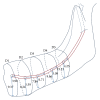Gaining surgical access for repositioning the inferior alveolar neurovascular bundle
- PMID: 24892077
- PMCID: PMC4032651
- DOI: 10.1155/2014/719243
Gaining surgical access for repositioning the inferior alveolar neurovascular bundle
Abstract
This study is aimed at determining anatomical landmarks that can be used to gain access to the inferior alveolar neurovascular (IAN) bundle. Scanned CBCT (i-CAT machine) data of sixty patients and reconstructions performed using the SimPlant dental implant software were reviewed. Outcome variables were the linear distances of the mandibular canal to the inferior border and the buccal cortex of the mandible, measured immediately at the mental foramen (D1) and at 10, 20, 30, and 40 mm (D2-D5) distal to it. Predictor variables were age, ethnicity, and gender of subjects. Apicobasal assessment of the canal reveals that it is curving downward towards the inferior mandibular border until 20 mm (D3) distal to the mental foramen where it then curves upwards, making an elliptic-arc curve. The mandibular canal also forms a buccolingually oriented elliptic arc in relation to the buccal cortex. Variations due to age, ethnicity, and gender were evident and this study provides an accurate anatomic zone for gaining surgical access to the IAN bundle. The findings indicate that the buccal cortex-IAN distance was greatest at D3. Therefore, sites between D2 and D5 can be used as favorable landmarks to access the IAN bundle with the least complications to the patient.
Figures






Similar articles
-
Anatomical configuration of the inferior alveolar neurovascular bundle: a histomorphometric analysis.Surg Radiol Anat. 2016 Mar;38(2):195-201. doi: 10.1007/s00276-015-1540-6. Epub 2015 Aug 14. Surg Radiol Anat. 2016. PMID: 26272703
-
Cone Beam Computed Tomographic Analysis of the Course and Position of Mandibular Canal.J Maxillofac Oral Surg. 2017 Sep;16(3):306-311. doi: 10.1007/s12663-016-0956-9. Epub 2016 Sep 9. J Maxillofac Oral Surg. 2017. PMID: 28717288 Free PMC article.
-
Inferior alveolar nerve canal position: a clinical and radiographic study.J Oral Maxillofac Surg. 2007 Mar;65(3):470-4. doi: 10.1016/j.joms.2006.05.056. J Oral Maxillofac Surg. 2007. PMID: 17307595
-
A review of the intraosseous course of the nerves of the mandible.J Oral Implantol. 1991;17(4):394-403. J Oral Implantol. 1991. PMID: 1813647 Review.
-
Microsurgical Decompression of Inferior Alveolar Nerve After Endodontic Treatment Complications.J Craniofac Surg. 2017 Jul;28(5):1365-1368. doi: 10.1097/SCS.0000000000003672. J Craniofac Surg. 2017. PMID: 28570409 Review.
Cited by
-
CBCT Evaluation of Buccolingual Orientation of Inferior Alveolar Canal in Mandibular Posterior Region for Implant Planning.Int J Dent. 2022 Aug 27;2022:4682105. doi: 10.1155/2022/4682105. eCollection 2022. Int J Dent. 2022. PMID: 36065398 Free PMC article.
-
Analysis of the mandibular canal course using unsupervised machine learning algorithm.PLoS One. 2021 Nov 19;16(11):e0260194. doi: 10.1371/journal.pone.0260194. eCollection 2021. PLoS One. 2021. PMID: 34797856 Free PMC article.
-
Buccolingual course of the inferior alveolar canal in different mental foramen locations: A cone beam computed tomography study of an Iranian population.Int J Appl Basic Med Res. 2016 Oct-Dec;6(4):262-266. doi: 10.4103/2229-516X.192589. Int J Appl Basic Med Res. 2016. PMID: 27857894 Free PMC article.
-
Mandibular Body Fracture during Inferior Alveolar Nerve Transposition: Review of Literature.Ann Maxillofac Surg. 2019 Jan-Jun;9(1):218-220. doi: 10.4103/ams.ams_2_19. Ann Maxillofac Surg. 2019. PMID: 31293959 Free PMC article.
-
Repair of Inferior Alveolar Nerve in Orthognathic Surgery Simulator (RIANOS): A Novel, Open-Source, Combined 3D Printed, and Ex-Vivo Chicken Sciatic Nerve Training Model.Craniomaxillofac Trauma Reconstr. 2024 Dec;17(4):NP31-NP35. doi: 10.1177/19433875241236322. Epub 2024 Mar 14. Craniomaxillofac Trauma Reconstr. 2024. PMID: 39569058 Free PMC article.
References
-
- Levine MH, Goddard AL, Dodson TB. Inferior alveolar nerve canal position: a clinical and radiographic study. Journal of Oral and Maxillofacial Surgery. 2007;65(3):470–474. - PubMed
-
- Ngeow WC. Is there a “safety zone” in the mandibular premolar region where damage to the mental nerve can be avoided if periapecal extrusion occurs? Journal of the Canadian Dental Association. 2010;76(1, article a61) - PubMed
-
- Pogrel MA, Thamby S. The etiology of altered sensation in the inferior alveolar, lingual, and mental nerves as a result of dental treatment. Journal of the California Dental Association. 1999;27(7):531–538. - PubMed
-
- Alling CC., III Dysesthesia of the lingual and inferior alveolar nerves following third molar surgery. Journal of Oral and Maxillofacial Surgery. 1986;44(6):454–457. - PubMed
-
- Renton T. Prevention of iatrogenic inferior alveolar nerve injuries in relation to dental procedures. Dental Update. 2010;37(6):350–360. - PubMed
Publication types
MeSH terms
LinkOut - more resources
Full Text Sources
Other Literature Sources
Miscellaneous

